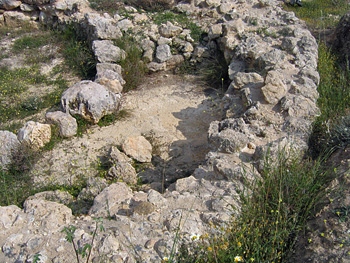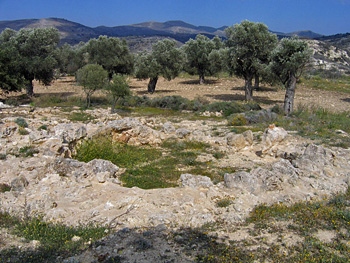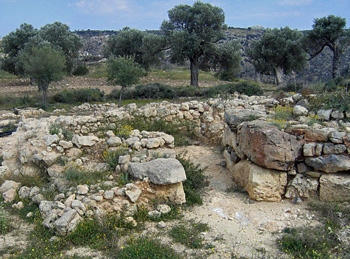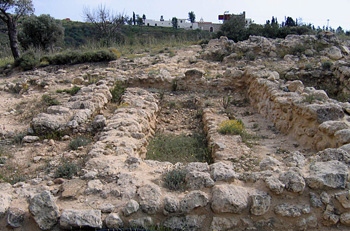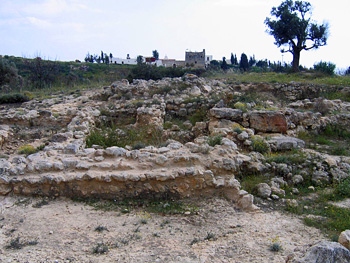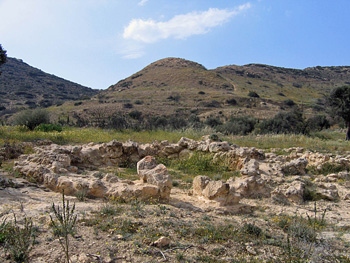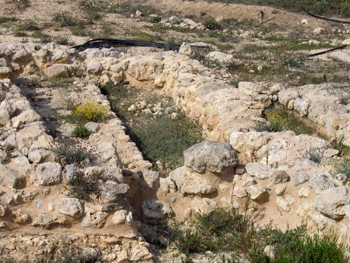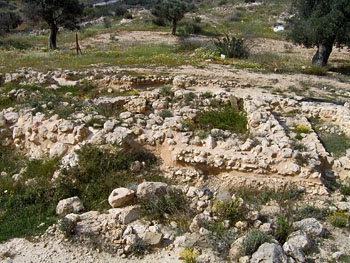
The Odiyitria (also Odigitria) cemetery is situated at the western end of the Asterousia mountains south of the Messara Plain in central south Crete. It takes its name from the Monastery nearby. After illegal looting of the tombs revealed the cemetery's existence, excavation of the site was begun by N. Dimopoulou in 1979 and completed by A. Vasilakis in 1980 following reports of further looting. The cemetery consists of two tholos tombs, A and B, a complex of rooms built to the east of tholos tomb B, courtyards, an ossuary, a possible altar and a peribolos wall.
Construction phases
On the basis of EM I pottery found at the site, the origins of the cemetery have been dated to the beginning of EM IA. Three construction phases were identified. The first was from the end of the Final Neolithic to Early Minoan I. Tholos tomb A contained an undisturbed deposit of EM I pottery at its lowest stratum, just inside the entrance. (It seems the looters covered this deposit with the fill from their digging further inside the tomb, thus protecting it from their looting). This made it possible to date the tomb. It is believed that Tholos A was the first to be built at the beginning of EM I and that Tholos B, though built in the same period, was possibly constructed a little later than Tholos A. This is hard to prove conclusively due to the complete looting of Tholos B in the distant past. What evidence exists for the building of the annexes and the peribolos wall and the couryard in front of Tholos B tends to confirm that it was also built in EM I. During this first phase the peribolos wall was also constructed, giving shape to the three courtyards, the East, Outer and North.
The second phase dates to EM II. Tholos B had an extra wall built all the way around its circumference not long after it was constructed. This is clear from the fact that the Rectangular Building (see below), which had been built by EM IIA, abutted the second outer wall, not the first inner one.
This second wall is a common feature of other tholos tombs in the Messara but in the other cases the tombs are smaller and the second wall only goes round part of the circumference of the tholos tomb (see for example photos on the page on Apesokari). One reason for building a partial, or in this case complete, second wall may have been to help support the stone vaulted roof. Perhaps an earthquake had exposed weaknesses in the original design and construction. Another explanation, offered by Keith Branigan, is that the second wall was built to make the tomb look bigger and therefore more impressive.
By the beginning of EM II a building with five rooms had been built outside Tholos tomb B. This has been named the Rectangular Building by the excavators. The entrance seems to have been in the north east corner of the complex into room c2 and from there via c1 and b2 into room a2, the room in front of the entrance to Tholos B. During this period two of the courtyards were laid with cobbles. The East Courtyard extended as far as the peribolos wall, and beyond the wall the Outer Courtyard was also laid.
In the third phase, from EM III onwards, less use was made of tholos A, although tholos A continued to be used throughout EM III and into MM IA. During EM III the Rectangular Building outside tholos tomb B was redesigned so that it only had three rooms. Rooms c1 and c2 became one room and rooms a2 and b2 were changed so that they formed two rooms running north to south incorporating the smaller rooms a1 and b1 respectively. The rectangular building continued to be used throughout the early protopalatial period (MM IB) and may still have been in use in MM IIA. At this point tholos tomb B was also taken out of use. The contents, both skeletons and pottery, were buried in the ossuary, and judging by the number of fragments of conical cups found in the soil, a final ceremony seems to have been held.
Tholos A
Tholos A is located on the south side of the cemetery. Like most tholos tombs in the Mesara it does not have any associated rooms. The original floor was laid in order to make the floor of the tomb level. This floor was removed by the excavators to prevent any further looting. The wall of Tholos A is just over one metre thick and stands one metre high at high its highest point. The internal diameter of the tomb was about four and a half metres. As is usual with tholos tombs, the entrance, which is trilithon in character, is on the east side and was quite narrow at 0.80 metre.
Excavators sieved the soil in Tholos A as well as excavating the part of the tholos floor that had been overlooked by looters. From the undististurbed area they found six pottery vessels. The most important other finds included a small piece of a stone vase, a piece of bone that had been sharpened into a blade, a small bronze knife, and many pieces of human bones including portions of two human skulls. From the sieved soil they found 13 pottery vessels, a bone pipe, a bone pendant, a necklace with 201 tubular beads and another with 68 spherical beads.
Tholos B
Tholos B, which is the larger of the two tombs, is located northwest of Tholos A. As already mentioned it opens into a series of rooms known as the Rectangular Building. Although the original wall is thicker than that of Tholos A it nevertheless had an extra wall added round the whole circumference of the tomb. Like Tholos A, the entrance to Tholos B is on the east side of the tomb. The type of tholos tomb represented by Tholos B seems to have brought together two distinct types of tomb. The local style in south central Crete is the round tholos tomb. Rectangular house tombs predominated in North and East Crete. In a number of tholos tombs in the Mesara, these two styles seem to have been joined together with the rectangular buildings built against the wall of the tholos tomb itself. Other examples to be found on this website include Apesokari, Kamilari, Platanos and Yerokambos.
The floor of Tholos B, like that of Tholos A was made of compacted white earth, though not much of it survived the looting. Fires seem to have been lit at the centre of the tomb floor, possibly to burn interred bodies. The wall of the tomb was built from large stones bonded together with smaller stones mixed with mud. The remains of the wall stand to a height of one metre at the highest point. The wall was about two metres thick. The outer wall is one metre thick and it is attached to the original wall. It has already been pointed out that similar outer walls were added to other tholos tombs but Tholos B at Odiyitria is unique because the wall goes all the way round the tomb. The entrance to the tomb was slightly wider than that of Tholos A at one metre.
The interior of Tholos B yielded only seven pottery vessels while the looters' earth from the tomb yielded only 16 pottery vessels, three stone vases, 14 seals made from faience, bone and soft stone, six amulets, three necklaces, the largest with 87 beads, two gold diadems, part of a human figurine made from ivory, one faience figure of a turtle, five bronze daggers, four bronze tweezers, a bronze cutter and a chisel.
The Rectangular Building
According to Vasilakis, buildings like the Rectagular Building are burial buildings in their own right, just as the house tombs are. He says they are more than simple annexes to the tomb, but are independent buildings which are built adjoining the tholoi. As he says, "they have their own structure, their own function, and are not organically connected with the tholoi."
There were two phases to the life of the Rectangular Building. In the first phase there were six rooms, a1, a2, b1, b2, c1 and c2 as shown in the plan on this website. Rooms c1 and c2, close to the entrance to the complex, were long, narrow rooms while rooms a1, a2, b1 and b2 were little more than small compartments. The ruins of this first phase were covered by a floor which was put in place when the Rectangular Building was redesigned. While the outer walls of phase two were in more or less the same position as the outer walls of phase one the rooms were rebuilt so that there were just three rooms, a, b and c, all oriented north-south.
The finds from the three strata were very few. In total only 35 vases were uncovered as well as parts of stone vases, a seal and a couple of pendants.
The Courtyards
A number of tholos tombs in the Mesara have both annexes and courtyards and it seems that the courtyards had some role to play in whatever rituals were conducted inside or in front of the annexe rooms.
There are four courtyards at Odiyitria though the northern one seemed to play a different role to the other three. The Southern Courtyard is located south of the annexe and East of tholos A. It is about 15 square metres in area. On its northeast side there is a peribolos wall. The southern courtyard was excavated properly in 1980 but the earlier excavation uncovered four pottery vessels, a bird's nest stone vase, and an eight-sided prism.
The Eastern courtyard, which is paved with stone slabs of schist, is immediately east of the annexe and its north and east borders are delineated by a peribolos wall. Attached to this wall east of the annexe is a rectangular structure which may have been an altar. On the other side of the peribolos wall that forms the eastern boundary of the eastern courtyard is the outer courtyard. The Eastern and Outer Couryards produced 164 vases in the 1979 exavation and a subsequent excavation in 2003. Other finds included animal figurines. In the northwest corner of this courtyard, attached to the peribolos wall, is room 1, a later addition about which little is known.
The northern couryard lies immediately north of the annexe. This couryard was partly surrounded by a peribolos wall. The western part of the wall was located to the north of Tholos B while the eastern part was located north of the Rectangular Building and the East Courtyard.
The Ossuary
When the excavators began digging between the two tholoi they uncovered the ossuary pit. A large number of bones were discovered, including 22 skulls in the top stratum alone. The other bones tended to be long bones from arms and legs. The skulls had been placed in groups of either five or ten. Other finds from the ossuary included ten pottery vessels, fragments from 3 stone vessels, a pendant and a bead from the top layer, stratum I. From stratum II eight pottery vessels, six stone vessels, two necklace beads and obsidian blades were recovered. From stratum III 11 pottery vessels were recovered along with 15 faience seals, 8 ivory or bone seals, two stone vases and obsidian blades.
Human remains
Examination of the contents of the ossuary suggest that at least some of the bodies had been placed there in a partially decomposed state rather than waiting for the process of decomposition to be completed. Fragments of pithoi which when complete must have numbered at least 17, were recovered from the cemetery and the excavators feel certain that they would have contained bodies, a practice carried out at other early Minoan tholos tombs. It is not possible to get a full picture, however, because the Minoans would have carried out occasional clearing of the contents of the tholos tomb and also because the cemetery has been extensively looted.
Sevi Triandaphyllou examined the human remains and came to a number of conclusions. It is important to bear in mind that Tholos A went out of use before Tholos B and so we may well be looking at the remains of different generations rather than contemporary generations in the two tombs. Firstly she believes that the treatment of the dead was different in the two tholos tombs. It seems that in Tholos A, the human remains had been buried elsewhere first and only later moved to the tomb, while in tholos B she believes that the dead were buried in soil inside the tomb and later moved to the ossuary in a secondary burial. This would have involved regular reopening of the ossuary pit to accommodate new additions of human remains.
She also believes that the two tombs catered for different sections of the population. The evidence seems to suggest that while a large part of the population of all ages and both sexes could be buried in tholos A, use of tholos B was limited to certain individuals, mainly adults.
The women in tholos B seem to be of average height when compared to the remains from other Minoan tombs, while the men are shorter than virutally every other Minoan population which has been measured. Although height can be determined by your genes it is also influenced by where you live and what you eat. It may be that the women had a better lifestyle than the men.
While life expectancy for Minoans in general has been estimated at 25 to 35 years, with men on average living longer than women, the skeletons in tholos B are of people who seem to have lived to 40 or 50 years old. Moreover they seem to have suffered different wear and tear to their skeletons. In tholos A damage occured more to the upper skeleton, suggesting physical manual work, while the remains in tholos B suffered more damage to the lower skeleton suggesting greater use of the legs and feet, probably in travelling on foot over uneven terrain.
Triandaphyllou also discovered from her examination of teeth that the people buried in Tholos B consumed more carbohydrate-based food than those in tholos A. It also seems that women consumed more of this carbohydrate-rich food than the men did. Overall, Triandaphyllou identified a slight decline in health between the group from Tholos A, dating to the EM I/EM II period and those in Tholos B which represented an EM II/early MM IB group.
Grave goods
The absence of grave goods due to looting makes it difficult to draw all but the most general conclusions and the one drawn by Keith Branigan is that "all the main types of vessels were deposited in the tombs as grave goods throughout the period of the cemetery's usage and ... cups were the most common type of pottery grave vessel at all times." The Ossuary contained a number of other finds including fragments of six stone vases, and nearly two dozen seals, pots, amulets and necklaces, gold diadems and a gold bracelet.
Almost no animal bones were found during excavations at the cemetery so it is not known whether food was left inside the tomb as an offering or if feasting formed part of the ceremonies surrounding interment of the dead.
Metal objects
Keith Branigan examined all the metal finds from the cemetery and points out that although 33 items were recovered dating to the Minoan period, this neverthelss represents the largest number of such items recovered from any of the tholos tombs on the southern slopes of the Asterousia mountain range. Comparing metal finds from the various tombs on both sides of the range, Branigan concludes that communities on the northern slopes had greater access to objects made of bronze than those on the southern slopes. At Odiyitria, as at Yerokambos, daggers make up a large proportion of the finds, no doubt because they were considered to be important grave goods. Some of the daggers almost certainly date back to EM II. Another important group of metal objects was made up of tweezers and scrapers -- toilet implements. However Branigan notes that the evidence suggests that only a very small number of burials made at Odiyitria would have been accompanied by bronze grave goods.
Obsidian blades
A large quantity of obsidian was found in the two tombs and the surrounding area. Almost all of it is thought to have come from the Sta Nychia quarry in Melos. Of the 474 pieces of obsidian collected, most of them had been worked into fine blades and 427 had been completed. Many of the other items of grave goods uncovered had been used and may have belonged to the people buried inside the tholos tombs. The vast majority (403 or 92.6%) of the obsidian blades, however, were unused as they had been made specifically for use as grave goods. However, every single one of them was broken, probably during the interment of new bodies throughout the life of the tomb
Tristan Carter, who examined the blades, says that using obsidian blades as grave goods was not a local practice in EM I. It had been acquired, probably via communities further north, from populations living in the Cyclades islands, to the north of Crete. He suggests that the most likely route for this practice to reach Odiyitria was across central Crete, starting at the Minoan harbour of Poros-Katsambas which had close trading links with the Cyclades. The blades weren't produced in the Cyclades although the obsidian came from there and so far there is no evidence that obsidian blades were produced in the Mesara Plain itself. However, working with obsidian was a major activity at Poros-Katsambas and other centres and it is possible that obsidian was worked into blades at places like Archanes or Knossos and then found their way to the Mesara Plain where they would be obtained ready-made by the settlements in the Asterousia.
There were differences between the blades produced in the Cyclades and those produced in Crete. In the Cyclades the blades were made using a different and more highly skilled technique and the blades tended to be longer than those used on a daily basis. In Crete this technique had not been learnt and the blades, though the finest examples, were made in the same way as domestic blades were.
The cemetery at Odiyitria contained a very substantial quantity of obsidian blades -- twice as many as any other tomb whose excavation has been published. Because of the looting, however, it is not possible to say anything about who among the dead received obisdian blades as part of their grave goods and who might not. Evidence from the cemetery at Phourni suggests that we cannot assume that one blade was buried for each person interred.
So why were obsidian blades so popular as grave goods? Carter argues that they have to be thought of as razors, as part of a larger "toilet kit" as he puts it. He notes that many toiletry items were made of exotic materials that would have required specialist knowledge to turn them into the required products and this would have reflected the status and prestige of their owners. It is clear, as Carter points out, that in the Early Bronze Age the body was one of the main ways in which people created and expressed social being. The wearing of seals or daggers would help certain men to identify the form of their power, while the wearing of necklaces and bracelets was also popular. Also popular were items for removing hair -- tweezers, razors and scrapers. The obsidian blades fall into this category and they are also often found buried together with these other items of toiletry. Again this was something that was shared in common between the people of the Cyclades and the people of South-Central Crete, though there were of course regional differences. In particular the people of the Cyclades went in for painting and tattooing their bodies while the Cretans never adopted this practice.
The practice of burying obsidian razor blades in tombs reached its height in EM II. Use of obsidian blades began to fall off in EM III and by MM I the practice had almost completely died out.
SOURCES: The key text for the cemetery at Odiyitria is Moni Odigitria: a Prepalatial Cemetery and its Environs in the Asterousia, Southern Crete by Andonis Vasilakis and Keith Branigan, published by INSTAP Academic Press, Philadelphia, which was used as a source for much of the information used in this text.


